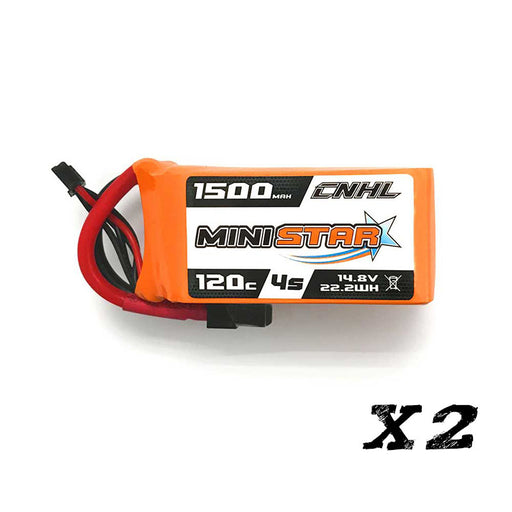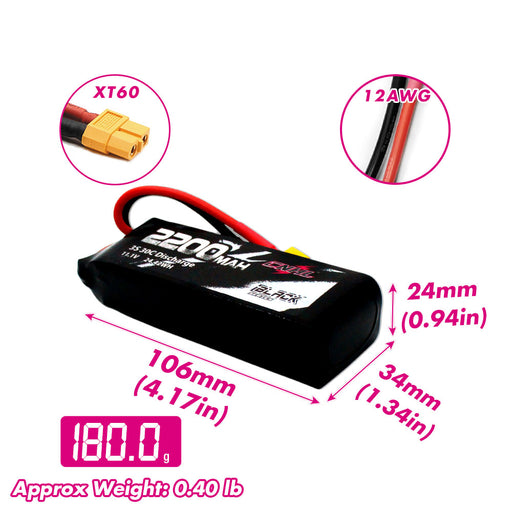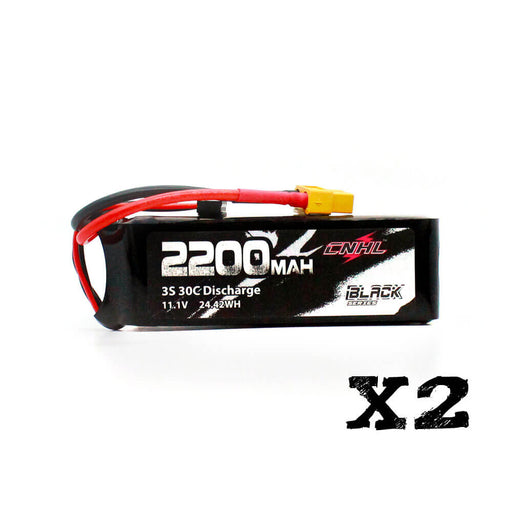
LiPoバッテリーが家を燃やさないようにする方法

ベストセラー
-
元の価格 $65.99元の価格 $65.99 - 元の価格 $65.99元の価格 $65.99$55.99 USD - $65.99 USD$55.99 - $65.99現在の価格 $55.99 USD
CNHL G+Plus 5000mAh 22.2V 6S リポバッテリー 70C EC5プラグ付き
在庫に10以上あります仕様: ストック番号: 500706EC5 容量: 5000mAh 電圧: 22.2V / 6セル / 6S1P 放電率: 70C 継続 / 140C バースト 充電率: 最大5C サイズ(1-5mmの誤差): 49X51X149mm(高さ*幅*長さ) おおよその重量(±5g) : 71...
詳細をすべて表示元の価格 $65.99元の価格 $65.99 - 元の価格 $65.99元の価格 $65.99$55.99 USD - $65.99 USD$55.99 - $65.99現在の価格 $55.99 USD最大15%節約 -
元の価格 $77.98元の価格 $77.98 - 元の価格 $77.98元の価格 $77.98$69.98 USD - $77.98 USD$69.98 - $77.98現在の価格 $69.98 USD
2パック CNHL スピーディピザシリーズ プロ 1350mAh 22.2V 6S 150C リポバッテリー XT60プラグ付き
在庫に10以上あります仕様: 在庫番号: 1351506PZ 容量: 1350mAh 電圧: 22.2V / 6セル / 6S1P 放電率: 150C 連続 / 300C バースト 充電率:最大5C サイズ(1-5mmの差異あり): 38X38X78mm おおよその重量(±5g): 215g 出力コネクター: ...
詳細をすべて表示元の価格 $77.98元の価格 $77.98 - 元の価格 $77.98元の価格 $77.98$69.98 USD - $77.98 USD$69.98 - $77.98現在の価格 $69.98 USD最大10%節約 -
元の価格 $51.98元の価格 $51.98 - 元の価格 $51.98元の価格 $51.98$41.98 USD - $51.98 USD$41.98 - $51.98現在の価格 $41.98 USD
2パック CNHL ブラックシリーズ V2.0 1300mAh 22.2V 6S 130C リポバッテリー XT60プラグ付き
在庫に10以上あります仕様 在庫番号: 1301306BK 容量: 1300mAh 電圧: 22.2V / 6セル / 6S1P 放電率: 130C 継続 / 260C バースト 充電率: 最大5C サイズ(1-5mmの差異あり): 48X33X77mm 重量(±5g): 210g 出力コネクター: XT60 バ...
詳細をすべて表示元の価格 $51.98元の価格 $51.98 - 元の価格 $51.98元の価格 $51.98$41.98 USD - $51.98 USD$41.98 - $51.98現在の価格 $41.98 USD最大19%節約 -
元の価格 $43.98元の価格 $43.98 - 元の価格 $43.98元の価格 $43.98$33.98 USD - $43.98 USD$33.98 - $43.98現在の価格 $33.98 USD
[Combo] 2パック CNHL MiniStar 1500mAh 14.8V 4S リポバッテリー 120C XT60プラグ付き
在庫に10以上あります仕様: 在庫番号:1501204 容量:1500mAh 電圧:14.8V / 4セル / 4S1P 放電率:連続120C / バースト240C 充電率:最大5C サイズ(1-5mmの差異):37X33X76mm おおよその重量(±5g):169g 出力コネクター:XT60 バランスコネクター...
詳細をすべて表示元の価格 $43.98元の価格 $43.98 - 元の価格 $43.98元の価格 $43.98$33.98 USD - $43.98 USD$33.98 - $43.98現在の価格 $33.98 USD最大23%節約 -
元の価格 $23.98 - 元の価格 $37.98元の価格 $23.98 - 元の価格 $37.98元の価格 $23.98$19.98 USD - $37.98 USD$19.98 - $37.98現在の価格 $19.98 USD
2パック CNHL ブラックシリーズ 2200mAh 3S 11.1V 30C リポバッテリー XT60プラグ付き
在庫に10以上あります仕様: 在庫番号:220303BK 容量:2200mAh 電圧:11.1V / 3セル / 3S1P 放電率:30C連続 / 60Cバースト 充電率:最大5C サイズ(1-5mmの誤差あり):24X34X106mm おおよその重量(±5g):180g 出力コネクター:XT60 バランスコネク...
詳細をすべて表示元の価格 $23.98 - 元の価格 $37.98元の価格 $23.98 - 元の価格 $37.98元の価格 $23.98$19.98 USD - $37.98 USD$19.98 - $37.98現在の価格 $19.98 USD最大17%節約
新しいアイテム
-
元の価格 $9.99 - 元の価格 $9.99元の価格 $9.99$9.99 USD$9.99 - $9.99現在の価格 $9.99 USD
CNHL ブラックシリーズ 2200mAh 7.4V 2S ショーティ リポバッテリー 40C T/ディーンプラグ付き
在庫に10以上あります仕様: 在庫番号:S220402BKT 容量:2200mAh 電圧:7.4V / 2セル / 2S1P 放電率:40C 継続 / 80C 瞬間 充電率:最大5C サイズ(1〜5mmの誤差あり):19X34X76mm 重量(±5g):103g 出力コネクター:T/ディーンプラグ バランスコネク...
詳細をすべて表示元の価格 $9.99 - 元の価格 $9.99元の価格 $9.99$9.99 USD$9.99 - $9.99現在の価格 $9.99 USD -
元の価格 $9.99 - 元の価格 $9.99元の価格 $9.99$9.99 USD$9.99 - $9.99現在の価格 $9.99 USD
CNHL ブラックシリーズ 2200mAh 7.4V 2S ショーティ リポバッテリー 40C XT60プラグ付き
在庫に10以上あります仕様: 在庫番号: S220402BK 容量: 2200mAh 電圧: 7.4V / 2セル / 2S1P 放電率: 連続40C / 瞬間80C 充電率: 最大5C サイズ(1〜5mmの誤差あり): 19X34X76mm 重量(±5g): 103g 出力コネクター: XT60 バランスコネク...
詳細をすべて表示元の価格 $9.99 - 元の価格 $9.99元の価格 $9.99$9.99 USD$9.99 - $9.99現在の価格 $9.99 USD -
元の価格 $399.00 - 元の価格 $399.00元の価格 $399.00$399.00 USD$399.00 - $399.00現在の価格 $399.00 USD
CNHL バイソン XT STOL 1750mm PNP ブッシュプレーン RC 飛行機 – FPV対応クリアキャノピー、高翼STOL
残り9台のみCNHL Bison XT STOL 1750mm PNP RC 飛行機(オレンジ) CNHL Bison XT STOL V2 は、ゆっくりと自信を持って飛行し、短距離離陸やFPVスタイルのクルージングに適した大型の高翼ブッシュスタイル航空機です。これは、空中での存在感が強く、前方の視認...
詳細をすべて表示元の価格 $399.00 - 元の価格 $399.00元の価格 $399.00$399.00 USD$399.00 - $399.00現在の価格 $399.00 USD -
元の価格 $264.00 - 元の価格 $264.00元の価格 $264.00$264.00 USD$264.00 - $264.00現在の価格 $264.00 USD
CNHL Havok 1000mm 高速 4S スポーツレーサー RC 飛行機 PNP(高視認性イエロー/レッドエディション)
残り9台のみCNHL Havok 1000mm 4Sスポーツレーサープレーン – 実績ある1m Havok機体をベースに CNHL Havok 1000mm 4SスポーツレーサーRCプレーンPNPは、日常の実用性を犠牲にせずアドレナリンを求めるパイロット向けの1メートルフォームスピードプレーンです。...
詳細をすべて表示元の価格 $264.00 - 元の価格 $264.00元の価格 $264.00$264.00 USD$264.00 - $264.00現在の価格 $264.00 USD -
元の価格 $120.00 - 元の価格 $120.00元の価格 $120.00$120.00 USD$120.00 - $120.00現在の価格 $120.00 USD
MNRC MN300 RTR 1/12スケール 4WD RC ロッククローラー オフロードトラック 2速トランスミッション付き
残り9台のみMNRC MN300は1/12スケールのレディトゥラン(RTR)4WD RCロッククローラーで、軽いクローリング、トレイル走行、日常のオフロードの楽しみのために作られています。電子機器が組み込まれた状態で組み立て済みで、7.4VバッテリーとUSB充電ケーブルが箱に同梱されています。「全か無...
詳細をすべて表示元の価格 $120.00 - 元の価格 $120.00元の価格 $120.00$120.00 USD$120.00 - $120.00現在の価格 $120.00 USD





















コメントを残す